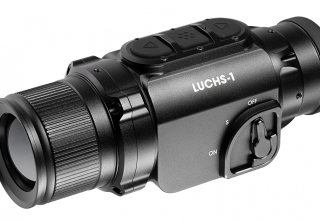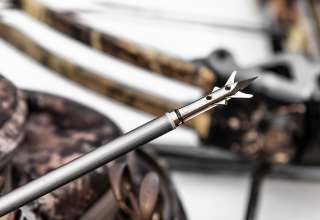You know this, but it bears reiteration: Arrows/broadheads aren’t bullets. Bullets kill largely through shock and some small measure of hemorrhaging. Broadheads are nothing more than aerodynamic cutting instruments that inflict massive hemorrhaging. Animals bleed more profusely when broadhead edges are as sharp as possible. We understand this, in the big picture, but some of the bad habits I observe while in hunting camps (including 23 years of guiding professionally) tell me many don’t understand the details.
 Interestingly, broadhead sharpness doesn’t affect penetration as much as you might believe. Arrows arrive on target at relatively high speeds—dynamic conditions completely different from pushing a broadhead through a given media from a static condition (in which case sharpness makes a noticeable difference). On average 40 foot pounds of energy is enough to achieve full penetration on deer-sized animals. Most adult male bowhunters shoot 65 to 85 foot pounds. Also, basing broadhead penetration potential on materials such as foam isn’t an accurate way to judge what might happen on game, as foam imparts a clamping effect not exhibited by flesh and bone.
Interestingly, broadhead sharpness doesn’t affect penetration as much as you might believe. Arrows arrive on target at relatively high speeds—dynamic conditions completely different from pushing a broadhead through a given media from a static condition (in which case sharpness makes a noticeable difference). On average 40 foot pounds of energy is enough to achieve full penetration on deer-sized animals. Most adult male bowhunters shoot 65 to 85 foot pounds. Also, basing broadhead penetration potential on materials such as foam isn’t an accurate way to judge what might happen on game, as foam imparts a clamping effect not exhibited by flesh and bone.
Where sharpness factors most dramatically is in the amount of blood left behind after every hit. Simply put, the sharper your broadhead edges the more blood an animal spills, and the faster it expires. This is especially pointed following marginal hits through muscle or the paunch area. More humane kills. Faster recovery.
New Archery Products (NAP) blades are unsurpassed in quality and sharpness. This starts with a better grade of (and more expensive) stainless steel. The better the material quality, the better that material will hold an edge. How that material is heat treated also factors. Too hard and blades become brittle, breaking after hard impacts or when subjected to torque. Too soft and blades bend when subjected to the same abuse, as well as not being able to hold a durable edge. NAP engineers have worked diligently to discover an ideal of optimal blade hardness (edge retention) and durability (resistance to breaking or bending).
 Chris Kozlik, NAP design engineer, says NAP blades remain in long coils through the stropping and heat-treating process, giving them more control over finished product, a process called strip grinding. And because they’re manufactured in house, NAP has complete control over quality. Kozlik also points out NAP blades receive multi-bevel edges, unlike blades that hold a single edge angle. This allows using thicker blades for structural integrity, up to three bevel angles resulting in edges that are sharper than surgical scalpels. If this sounds farfetched, remember that surgeons want the cuts they produce to heal faster—while bowhunters want wounds less apt to clot or clog. A sharper blade producing cleaner cuts result in increased hemorrhaging and faster bleed-out.
Chris Kozlik, NAP design engineer, says NAP blades remain in long coils through the stropping and heat-treating process, giving them more control over finished product, a process called strip grinding. And because they’re manufactured in house, NAP has complete control over quality. Kozlik also points out NAP blades receive multi-bevel edges, unlike blades that hold a single edge angle. This allows using thicker blades for structural integrity, up to three bevel angles resulting in edges that are sharper than surgical scalpels. If this sounds farfetched, remember that surgeons want the cuts they produce to heal faster—while bowhunters want wounds less apt to clot or clog. A sharper blade producing cleaner cuts result in increased hemorrhaging and faster bleed-out.
Some confusion arises with blades so sharp, as with a decently-sharpened blade you might feel resistance when, say, stroking edges with a thumb edge. With a truly sharp edge you should feel nothing. On the first instance your thumb is catching on the burr, which can break off and leave a dull, rounded edge.
As a quick aside, serrated blades aren’t sharper than straight edges, but serration does cut through tough bone better, should you dead-center a rib or hit a shoulder blade. You’ll notice NAP Edge models include a short section of serrated blade, the larger portion straight edged to slice hide, flesh and vital tissue more cleanly for increased hemorrhaging.
 Kozlik doesn’t recommend resharpening used NAP blades, as the multi-bevel edges make it difficult to reproduce factory results. As a former big-game guide I recommend changing blades often; especially after target practice into foam targets. Even removing and returning broadheads from foam-line quiver hoods eventually takes the scary-sharp edges off of broadheads, especially a dirty foam liner. You’ve a lot invested in your bowhunt, don’t cut corners when it comes to a $15 package of fresh blades.
Kozlik doesn’t recommend resharpening used NAP blades, as the multi-bevel edges make it difficult to reproduce factory results. As a former big-game guide I recommend changing blades often; especially after target practice into foam targets. Even removing and returning broadheads from foam-line quiver hoods eventually takes the scary-sharp edges off of broadheads, especially a dirty foam liner. You’ve a lot invested in your bowhunt, don’t cut corners when it comes to a $15 package of fresh blades.
NAP goes to great lengths to provide you with the sharpest blades possible, going so far as to engineer special packaging, so nothing touches blade edges from the moment they come off the assembly line to the day you screw them onto your hunting arrows. If in doubt, conduct a simple test by stretching a rubber band between index finger and thumb and pushing the broadhead blade across the stretched rubber. It should cut instantly. If it fails to do so it might also fail to slice vital arteries making recovery that much faster and easier.
Be sure to read our article on broadhead selection to ensure a successful hunt, Fixed or Mechanical Broadheads?
- Gaining an Edge With Sharp Broadheads - November 17, 2017
- Using Scents to Create Higher-Odds Bow Shots - November 7, 2017
- Fundamental Crossbow Maintenance - October 25, 2017

















